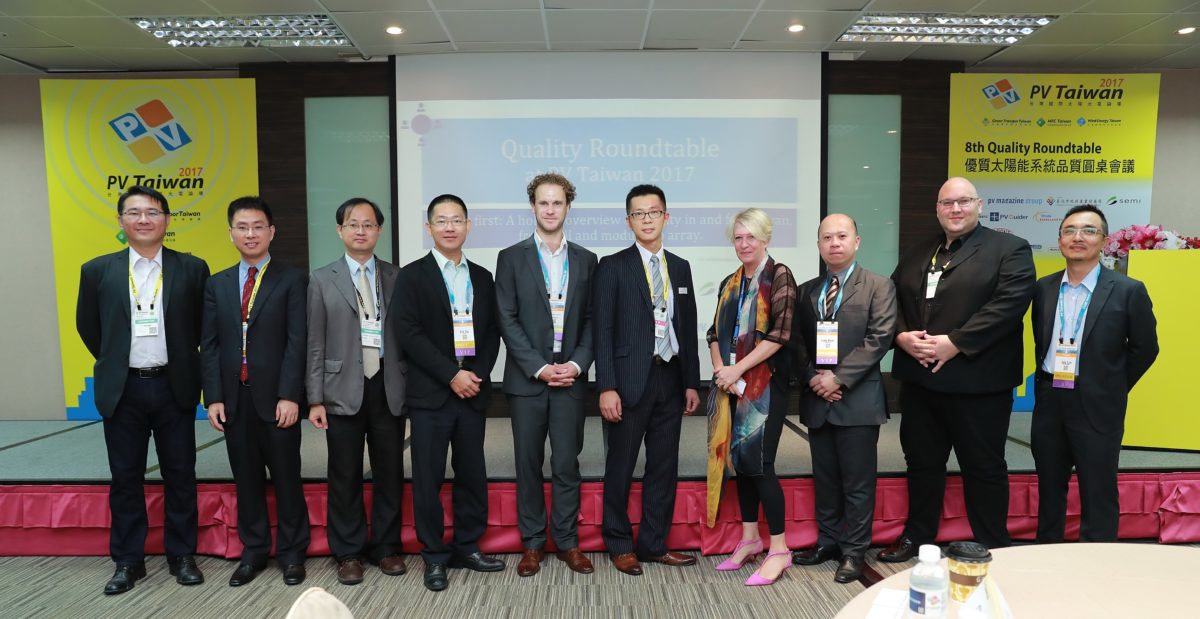At this year’s PV Taiwan, pv magazine’s very own Editor-at-Large led the 8th Quality Roundtable on Friday, October 20 at room 504bc at the Taipei Nangang Exhibition Center. The Quality Roundtable invited a host of industry insiders and experts from various industry segments to share their perspectives and experiences on quality in solar PV. Discussions ranged from economic issues, technical perspectives and the challenges of meeting government policy and the opportunities going forward.
Moderator Jonathan Gifford was joined by lead presenter Dr. Jay Lin, Chief Consultant of PV Guider, as well as member of the Technical Committee of CNS National Standards and the Leader of Task Forces in SEMI standard.
Mr. San-Chung Wang, Deputy Commissioner, Department of Economic Development, Taipei City Government was the opening presenter, discussing Taipei City accomplishments and initiatives in solar PV development. Taipei City is a densely populated urban environment, which presents significant challenges to solar power development, as the forum’s second presenter, Mr. Leo Kuo, Senior Manager with Tatung Co., the parent company of Taiwanese solar wafer maker Green Energy Technologies (GET), highlighted in his presentation on “Solar Installation at Urban / High Density Area.” Small scale rooftops, tall buildings exposed to high winds, and a multiplicity of owners are just some of the many challenges that Taiwan must face before it will see largescale urban solar installations.
Taipei is located on the Tropic of Cancer, and like most tropical regions, sees distinct challenges due to heat and humidity, as well as typhoons that regularly barrel across the island. Solar PV installations in these environments are exposed to corrosion hazards and reduced output, not to mention damage inflicted by typhoons, and Gifford and Dr. Jay Lin discussed the specific National Standards that SEMI’s task force has enacted to mitigate against these hazards.
As Taiwan is a small island of only 35,000 square kilometers, two thirds of which is steep mountains unsuitable for development, perhaps the most significant limiting factor facing solar PV development in Taiwan is the extremely limited area in which to install ground mounted solar. Floating PV, therefore, presents a distinct opportunity for Taiwan to overcome this limitation. Mr. Cédric Jaeg, General Manager, Ciel & Terre Taiwan, then discussed the opportunities of floating solar on Taiwan’s many fish farms, reservoirs, and other bodies of water, as well as the need for high output panels to compensate for the generally smaller scale, as well as durability and resilience in light of the extreme weather.
Many other speakers discussed a number of other crucial issues facing the industry, including the need for quality in solar PV’s unsung heroes — cables and connectors, which are at the heart of the majority of system failures, the need for quality regulations guiding the solar industry, and necessity of quality manufacturing technology, production equipment and quality assurance in manufacturing.
Of particular resonance with the many industry insiders in attendance were the case studies in poor quality, which provoked lively discussion and exchange of views. When a typhoon causes damage to a solar PV installation, who is to bear the responsibility? the installer, the owner, the manufacturer, the government? What about if a system installation fails to perform as expected due to microcracks and hotspots on the panels? These and many other issues were discussed and attendees expressed great appreciation for hearing the many different points of view.
By Tim Ferry
This content is protected by copyright and may not be reused. If you want to cooperate with us and would like to reuse some of our content, please contact: editors@pv-magazine.com.



By submitting this form you agree to pv magazine using your data for the purposes of publishing your comment.
Your personal data will only be disclosed or otherwise transmitted to third parties for the purposes of spam filtering or if this is necessary for technical maintenance of the website. Any other transfer to third parties will not take place unless this is justified on the basis of applicable data protection regulations or if pv magazine is legally obliged to do so.
You may revoke this consent at any time with effect for the future, in which case your personal data will be deleted immediately. Otherwise, your data will be deleted if pv magazine has processed your request or the purpose of data storage is fulfilled.
Further information on data privacy can be found in our Data Protection Policy.